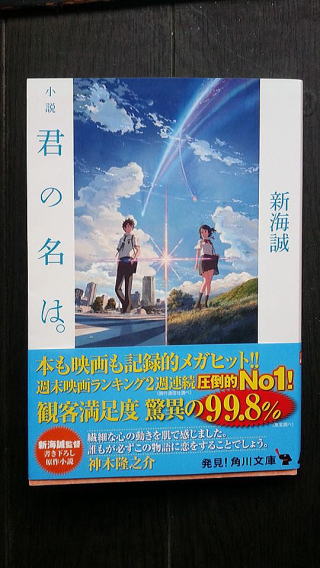Woolfさんの書き込みにあるYoshio Markinoについては「牧野義雄」参照
アニメーション映画「君の名は」監督・新海誠 渋谷TOHOシネマ
Pさんがとても感動したと言っていたので、私も映画館へ足を向けた。「このアニメ映画は、映画館の大画面で見ないと値打ちがわからないですよ」とPさんの言う通りだった。
男女の人格がある日入れ替わるというモチーフは、数年前、韓国テレビドラマ「シークレット・ガーデーン」で面白く描かれていて、それを見た人には、一種の既視感を抱くかも知れない。しかし、本作品の方は、それ以外に、隕石による大惨事などスケールの大きな話題を含み、東京都いう大都会の景観、逆に、アニメならではの細部の描写があり、ワンカット毎に楽しめた。
ジブリのアニメとは一味異なり、ここにもまた、素晴らしい日本的、写実的アニメが存在することが知れる。高校生の男女を主人公としているので、若者向けの作品であるが、高齢者にも楽しめる。
新海誠『小説 君の名は。』角川文庫 (1)
映画を監督自身がノベライズしたもので、「あとがき」によると、映画を作りながら書いて、映画完成の3ヶ月前に出版されている。普段、この手の本には手を出さないのだが、先のキャロル協会大会後の懇親会で、安井泉先生が、一つの事柄にいろんなアプローチがあり、当協会もそのようなものだと言う話の中で、この本を取り上げられておられたからである。画像、映像の世界と文章の世界とどんな差異があるか味わってみるのも一興かと買ったのである。もうひとつの動機は、今Pさんと読んでいる『坊ちゃん』がもうすぐ終わるので、息抜きに、易しい日本語の本を教材に使ってみようと思ったからである。
一読して思うことは、文章の情報量は、映像の情報量に比べて圧倒的に少ないことである。新海誠の小説家としての力量にも関係するのだが、この小説を読んで、映画で描かれている世界の百分の一も想像できないだろう。映画を見て感激した若者が手にするだろうと見込んでの作品かもしれない。
アニメ作品「君の名は」がヒットした理由は色々あろうが、私は、この作品が所謂「自分探し」の物語だからであると思っている。ある日、ヒロイン三葉のノートに誰かが「お前は 誰だ?」と見覚えのない筆跡で書き込まれているシーンが、この世界への入口である。男女の性の入れ替わりというデーマも、ユング流に言うと、自己の潜在意識にある、反対の性の原像(アニマ=男性の中にある女性の原像、アニムス=女性の中にある男性の原像)の存在に気づかせてくれる、直接的な方法なのである。この作品は、それ以外にも、友達、家族、田舎と大都会、聖(神社)と俗(政治)、大事故、恋・・・の中で自分を確かめて行く。入れ替わった二人がスマホを介して交信するのは現代風、しかも、交信している相手は実はもうこの世の人でないとするとどうなるのか?小説の初めの方にてくる、「エヴァレット多世界解釈」の世界へと誘い、自己を深化させる。「君の名は?」は「お前は誰か?」と同じなのである。
映画と小説の差異は、情報量の圧倒的な違いであるが、文章では情報の足りないところを、読者が想像力で補って行くとのになるのだが、映画が一方的にこちらに押し寄せてくるのに対して、読書の方は、少なくともそのスピードを読者がコントロール出来る。

君の名はに関してとても興味深いコメントでした。
自分探しの旅。今の若者は精神的な繋がりを未知の誰かにもとめているのかもしれないなぁとも思いました。神社、神秘、田舎と都会、なかなか不思議な関わり合いのなかでのストーリーでした。お気に入りの映画になりました。
坊ちゃんも読まれているのですね。
四国松山も良いところですね。
「坊ちゃん」は後一回で読了。その次はこの作品を読みます。
結び、とても興味深いアイテムです。
映画の聖地がいつも生活圏内ということもあり、何度か訪れました。映像の美しさもまた、引き込まれるものがあります。
Jenny Woolf I had not heard of the idea of the braid before I saw the film but it is an interesting idea. I thought the film was very beautiful, my favourite bit was the sacred dance in the temple and I wish I could see more.
-
Jenny Woolf I have learned some things about Japanese religion and culture by watching certain anime movies. I probably don't understand them correctly, but they are a "starting point" to enable me to learn more. .
-
Jenny Woolf I don't understand the Japanese translation (google does really weird Japanese translation!!) So forgive me if I am mistaken but I think you are talking about the anime called Kimi no Na wa in Japanese. In English it is called "Your Name" . i saw it on the plane from Japan and liked it very much but it is not yet available in the UK . I want to see it again. It made me think about the idea that our own imagination affects our perception, and influences how we live our lives. Ive been reading a very old book by a Japanese man Yoshio Makino who lived in England but tells of his upbringing in an educated poetic and philosophical home in Japan 1874-1894. He discusses this concept of private belief in relation to religious Ideas. He thinks stories are very important in shaping our views.
-
宮垣弘 Hallo Jenny Woolf san ! I always enjoy your pictures on Facebook. Thank you.
You were lucky to see “Your Name”. Kimi no Na wa in Japanese means “ What is your name?” I regard this work as a story of search for the Self. Makoto Shinkai, the Director, is influenced by not only old Japanese religious ideas but the anima and animus theory in Carl Jung's school of analytical psychology, on the many worlds interpretation by Hugh Everett, etc..
I don’t know Yoshio Makino. Was he a painter?
I am going to read a book which is novelized this anime by the director with an English gentleman. I hope this will make my understanding on this anime deeper.
- Jenny Woolf Thank you for your reply! I don't know the work of Hugh Everett but I am very interested in some of these ideas. Generally I prefer to explore them in fictional terms because I think the true meaning lies in emotional understanding. However, it's also necessary to have an intellectual framework.
-
Jenny Woolf Yoshio Markino was a painter 1874-42. He was born in the countryside near Toyota in 1874. His father was a samurai but had become poor. I wonder if any of his books ever appeared in Japanese? They are most unusual because he did not allow his writing to be edited in order to seem as if he was an English person. So the books are expressed as a well educated Japanese person would actually speak, i.e. with a different rhythm and slightly different use of language than an English person, and a conversational tone. He believed sincerity and truthful expression were important. His autobiography contains many interesting and unfamiliar ideas to me, but perhaps they would seem more familiar to a Japanese person.
-
宮垣弘 Thank you for your information. I will search his works.
-
-